Liverpool’s attacking patterns have changed under Arne Slot, and here Harry McMullen takes a closer look at the Reds’ right-sided blueprint.
“Timing beats speed.”
So goes the adage in prizefighting, and the same has proved true for Liverpool’s attack this season.
The sight of Liverpool players queuing up at the back post has been a theme of the Arne Slot era so far, and it’s all thanks to the Reds’ ability to steal a march on their opponents and find space to finish.
We are what we repeatedly do
An early example of this blueprint came in the 4-1 win over Sevilla in pre-season. From build-up, Alisson plays long toward Mo Salah. As he drops to meet it, Dominik Szoboszlai begins to sprint towards the space in behind.

Salah sets it back to Diogo Jota, which gives Sevilla’s defence a split-second headache: follow the ball or follow the run of Szoboszlai?
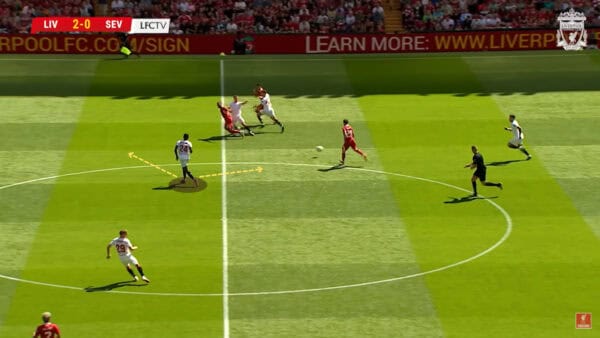
This gives the Hungarian an advantage, as he’s already at full speed when the ball is played, with his opponents just starting to give chase.

That allows him to get on the end of Jota’s pass, the covering defender is dragged across, and Luis Diaz is free on the left for a tap-in.

The pattern continued into the season proper. Against Bournemouth, it’s Ibrahima Konate looking for Salah under pressure.

As the Egyptian drops to meet it, Trent Alexander-Arnold is already bursting into space beyond him.
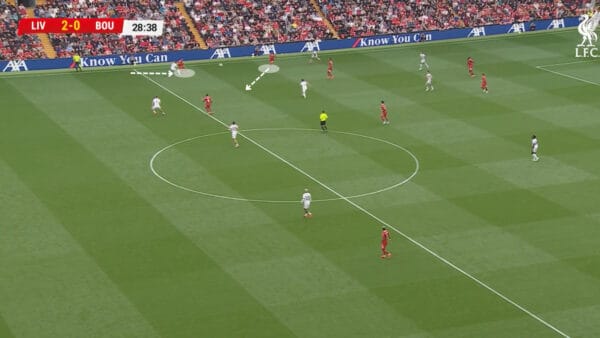
The defence is left back-pedalling as Alexander-Arnold carries the ball forward.
With Salah reversing his run to occupy Milos Kerkez and Szoboszlai joining the attack, Bournemouth‘s backline is pulled across to cope with the danger.

Therefore, Diaz is totally free to control a simple pass and fire in Liverpool’s second.
The right-hand lead

Salah has been the chief goalscorer for several years at Liverpool – but he’s been especially integral since the club transitioned from the famous front three to the rotating six forwards of today.
This made the Reds resemble an orthodox boxer, softening up their opponent with a left-hand jab before throwing a knockout punch from the right.
That’s an effective approach in combat, but it can be a predictable rhythm. And with Salah being a volume scorer, needing several chances per goal (as opposed to a one-punch knockout like Erling Haaland), it leaves Liverpool overly dependent on his output.

If he’s kept quiet in a game, Liverpool fall on the wrong side of the fine margins at the elite level.
This new pattern of play functions more like a right-hand lead. Throwing the dominant hand first upsets the opponent’s rhythm and creates an opening in their defence. And while the left hand that follows may not be the dominant one, it can still knock you out.
Instead of Salah’s finishing being the focal point, his strength, hold-up play and perfect decision-making in the final third are being used to create chances for his teammates.

Diaz and Cody Gakpo have been hard workers and popular performers since their respective arrivals, but neither has registered the necessary end product for Liverpool’s ambitions – until now.
For Gakpo, his stats are skewed by how often he comes off the bench to see games out. His improvement may be less noticeable than Diaz’s, but keep an eye on his stats as the season progresses.
Diversity in attack
In the 2-0 win over Bologna, we saw further glimpses of Liverpool’s strategy generating goals from around the squad.
Here, once again, it’s Konate under pressure, and Salah is on hand to give him an escape route.

Alexander-Arnold is already dashing into the space behind Salah, meaning the defender is frozen between following Salah and dropping to cover the full-back’s run.
Salah can therefore find Alexander-Arnold with one touch, and he’s immediately free.

Then it’s just a simple pass to release Darwin Nunez – but although he finds the net, he is denied by the offside flag.
The ability to manipulate the timing of the play gives Liverpool greater control of their attacks. Teams will already be wise to what Slot’s men are going to do, but stopping it is another matter entirely.
For the opener, a loose aerial ball leaves both sides slowing as they prepare for it to fall.
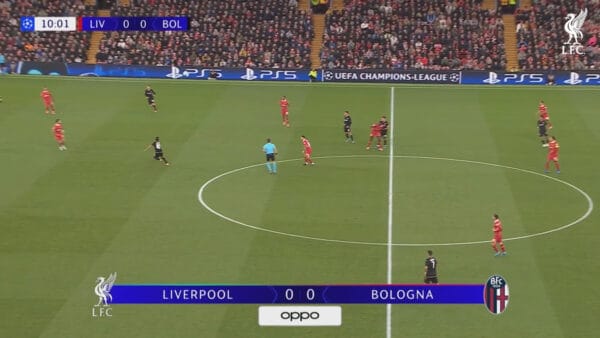
Once the ball is under control, Salah drifts wide and waits to get it.
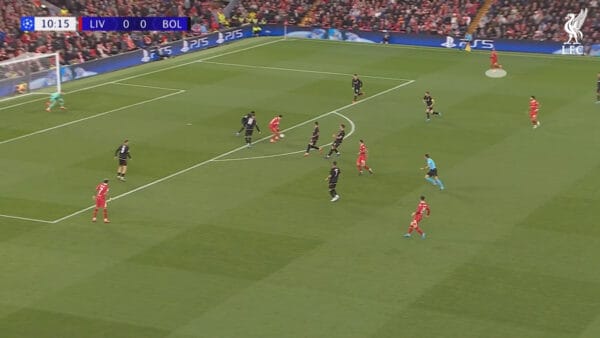
Thanks to a quick give-and-go from Alexis Mac Allister, Liverpool inject some tempo into the game, leaving Bologna to play catchup. Salah receives in space, but he waits for the Bologna defence to react before playing his cross.
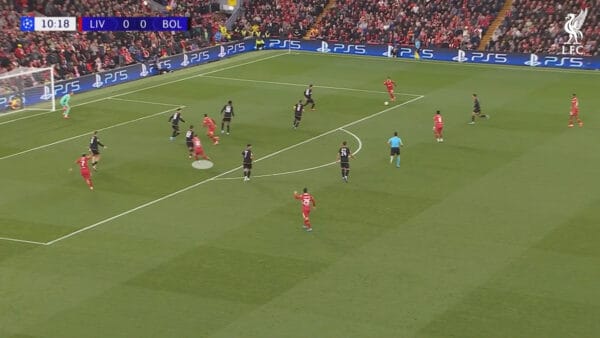
Mac Allister is already making his run from deep, which the defence doesn’t notice as their eyes are on the ball. That means he’s the favourite to reach Salah’s delivery and turn it in.

Late-arriving runs from Curtis Jones were a brief theme of the 2022/23 run-in, and the possibility of greater output from midfield bodes well for Liverpool’s aspirations.
Salah remains the top scorer at the club, and the straight right-hand remains the strongest punch Liverpool can throw.
But the new right-hand lead means a variety of other blows can land – making Liverpool all the more dangerous.

















Fan Comments